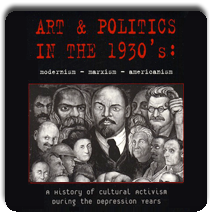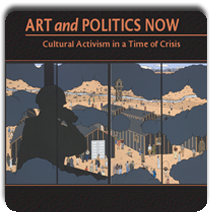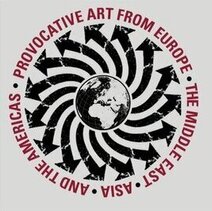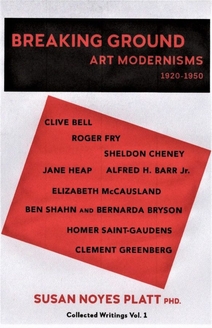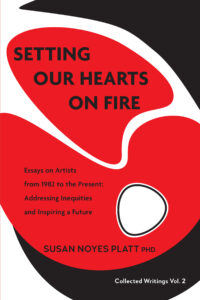A contribution to my blog by art historian Pamela Allara
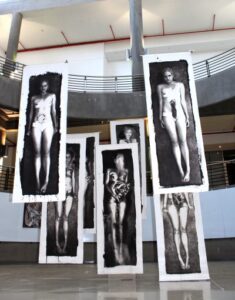
Heidi Mielke is a visual artist who is the education manager at Artist Proof Studio in Johannesburg. In the” Sentinels” series of Vandyke prints on cloth, she addresses the concept of the female nude in art from a political/activist perspective. The prints are life size, all posed by the artist.
When one brings to mind the image of the female nude in Western art history, for instance from Titian to Manet, one sees a reclining figure, often on a bed, gazing alluringly out at the viewer, ready to be mounted. Although feminist artists challenged that ‘one-dimensional’ portrayal of the female nude by presenting more realistic, less idealized images from the 1970s on, often these ‘naked’ nudes remain prone or seated. I am thinking in particular of Alice Neel’s portrait nudes, including her own from 1980. Of her many nudes, only her 1934 portrait of her naked 10-year-old daughter Isabetta is standing. But there is one exception: the well-known South African artist Marlene Dumas, whose standing nudes, either in ink or oil paint, are unabashed in their nakedness—indeed they appear to celebrate it. I assume that Mielke knows the work; certainly, she appears to be building on it. Nonetheless, I did not have Dumas in mind when I saw Miele’s images in her talk. It was my own long-standing expectations of the female nude that caused me to be taken aback by Mielke’s “Sentinels Project”. The nudes are standing! In that posture they become confrontational, but what precisely may that mean?
Mielke describes the project in detail on her website, https://heidimielke.com, I will summarize some of her main points. In her prints and paintings, the artist uses her own body to perform. She present us with examples of violence against women, which, she argues, still predominatein the ‘new’ South Africa. She began the series in 2013 after learning of the violent rape and murder of a 17-year-old woman, Amene Booysen, who was disemboweled in the process. That horrific event propelled her toward an activist art.
Mielke continued the series in 2016 during the perpetrator’s trial. Her aim has in general been to provide a heightened consciousness of social justice issues in a patriarchal country that has failed to overcome the discrimination and victimization of women. After her masters exhibit in the Women’s Jail at the Constitutional Court in 2015, she began to incorporate newspaper clippings and drawings on the women’s bodies transforming them into landscapes of violence. Should such violence simply be accepted? “Over my dead body!” she exclaims in her exhibition of that title.
When displayed, the “Sentinels” must be seen one at a time as they are life-sized. All are self-portraits of the artist. The figures appear to be standing, but their feet are crossed, so they must be either hanging or lying down. The dark ground suggests to me that they are lying on a slab, but overall, their ambivalent position suggests the figures are being raised from the dead. They were murdered, but here they are given a voice. And through the objects that they carry and the words that are written across and around them, they speak.. We cannot claim to know or understand these violent acts, but with careful viewing we are forced to confront the ways in which the artist presents violence.
In response to my query, the artist replied that in some of the images, “I am holding pieces of dead livestock, such as a pig’s head, a cow’s tongue, and a bull’s heart” which create a comparison between the slaughter of livestock and that of the victims. (email, October 7, 2024). In violent death, the distinction between human and animal is in some sense obliterated. Mielke added that some objects refer to the objects used to perpetuate the murders. For example, in a case from 2013 as reported in IOL news, Duduzile Zozo, who was lesbian, had a toilet brush shoved up her vagina as a sort of corrective rape.
Surprisingly, despite the horrific circumstances of their demise, the victims, as represented by Mielke’s self-portraits, are not as disturbing as one might expect. The bodies suspended before us are upright and do not appear at all to be in pain. Instead, they are performing as sentinels, by keeping watch, impassively, calmly, and continuously. They do not permit us to forget or to turn away. In Mielke’s words, they are like superheroes that guard us from being overwhelmed and fearful of confronting violent death. Through collaborating with artists both locally and internationally, she hopes to create an army of sentinels creating awareness of gender-based violence. I look forward to seeing how this important and moving project continues.
This entry was posted on November 24, 2024 and is filed under
Uncategorized.
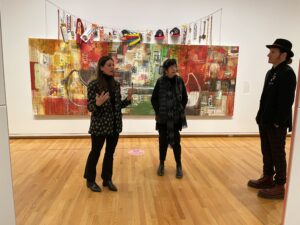
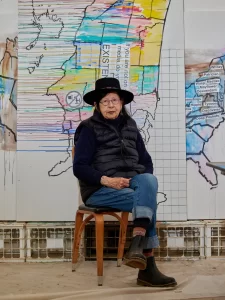
Jaune Quick To See Smith (center)and her Son Neal Ambrose-Smith with Whitney Curator Laura Phipps at “Memory Map,” exhibition in Seattle Art Museum, in front of Gifts for Trading Lands With White People
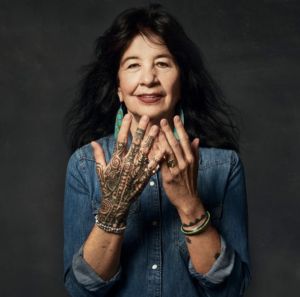 Jo Harjo reading her poem “Running” from her book An American Sunrise
Jo Harjo reading her poem “Running” from her book An American Sunrise
https://www.youtube.com/watch?v=Y8vwqWJsJiI
During one amazing week in March in Seattle Jaune Quick-to-See Smith (citizen of the Confederated Salish and Kootenai Nation) and Joy Harjo ( Mvskoke Nation) were both in Seattle. Jaune was here to open her one person exhibition at the Seattle Art Museum and Joy Harjo did a reading at our local “Town Hall” a cultural center.
Above you see Jaune and her son Neil with whom she collaborates, at the opening ,in front of Gifts for Trading Land with White People
Joy did a poetry reading and presentation, I only took a video of her. which I have’t figured out how to post it.
The correspondence between the two artists is extraordinary. Jaune is 11 years older, but they speak in the same voice, one in poetry, the other in painting. of the oppressions of colonialism. Jaune is also poetic and Harjo painterly ( she started as a painter)
Neither of them were subjected to the boarding school experience, one because her father was a horse trader who moved from place to place, the other because she was school age when this was not an automatic policy of the US government. But both knew people who were. It began in 1869 and continued to the 1960s. Joy’s autobiography Crazy Brave tells us of her deeply painful childhood and teen years.
Jaune helped develop the Institute of American Indian Arts which has been instrumental in the flowering of contemporary Native artists.
Joy attended that school as a student and it was there she decided to switch from painting to poetry.
Both speak of the native experience. In Joy’s case she is the great great granddaughter of a famous warrior Monahwee, who resisted Andrew Jackson’s removal order in the 1830s. In Jaune’s case her experience of moving consantly and living with different Native groups gave her an unusual education into shared Native experiences .
Joy’s poetry emphasizes the experience of removal as a point of departure. She provides a map of her own people’ s ( the Muscogee Creek removal from Alabama to Oklahoma) she points out
” There were many trails of tears of tribal nations all over North America of indigenous people who were forcibly removed from their homelands by government forces. The indigenous peoples who are making their way up from the Southern Hemisphere are a continuation of the Trail of Tears.” ( emphasis added)
As we listened to her presentation and then her poetry we heard her compelling voice speak of the native perspective on the earth as part of us, not as a source of money. “Respect the giving and give back, do not be complacent, stories tap on our shoulders, .. every one has a story.. one person may be many generations. Stories have layers, you get there by listening, take time.”
Meanwhile Jaune spoke in her exhibition of her art as a type of trade
she emphasizes trade canoes, with eight all together in the exhibition, each with a different theme. But just outside the exhibition was a drawing of coyote, the trickster creator, as a prelude to all that comes after. Placing him at the beginning suggests that the artist also sees herself as a trickster.
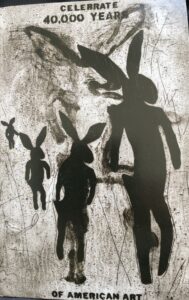
The first work we see inside the exhibition is 40,000 years of American painting that reminds us how short is the time of colonialism, the English language in North Americam as well as the art conventions brought in from Europe and called American after a Spanish explorer.
The stupendous paintings layer many realities. In addition to canoes, her major framing images are maps, clothing, horses, buffaloes, animals and figures.
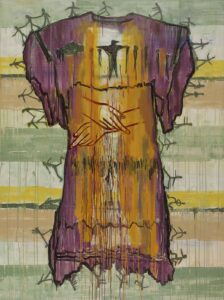
But in each case the image is filled with many references to myths and history: Who Leads Who Follows for example has the overall motif of a traditional dress, marching around the entire edge of the dress are stick figures,On the chest area is a raven/human and not far away is a buffalo. two outlined hands fold across the abdomen. Many signfiers , and what does it say?
We can read fragmentation and survival.
The theme of the Native American survival in spite of so many efforts to obliterate them is at the core of both Harjo’s poetry and Jaune’s painting,.
To elaborate on Jaune’s exhibition:
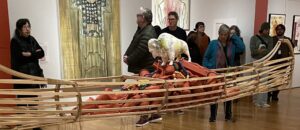 Trade canoes are a major theme. In this exhibition we have eight, two actually built of pinewood lath with her son Neal Ambrose-Smith. On one we see a carved white buffalo. The white buffalo has great significance to Lakota and Plains Indians. On June 4, 2024, a white buffalo calf was born in Yellowstone National Park Lakota Sioux chief Arvol Looking Horse said in an interview “The birth of this calf is both a blessing and warning. We must do more,”
Trade canoes are a major theme. In this exhibition we have eight, two actually built of pinewood lath with her son Neal Ambrose-Smith. On one we see a carved white buffalo. The white buffalo has great significance to Lakota and Plains Indians. On June 4, 2024, a white buffalo calf was born in Yellowstone National Park Lakota Sioux chief Arvol Looking Horse said in an interview “The birth of this calf is both a blessing and warning. We must do more,”
As an object in itself a canoe can simply refer to a means of transportation and community connection. The cultural significance and challenges of canoe journeys are now familiar to us. Revived in 1989, this year hundreds of canoes from all over the Northwest came to Alki Beach where the Denny party landed in 1851 greeted by Chief Seattle.
The artist states:
“Remember when the trade canoes came up river, they would be piled with bags of moldy flour, wormy beef, whiskey laced with lead and blankets smeared with smallpox” (p. 21 Memory Map, interview with Lowery Stokes Sims
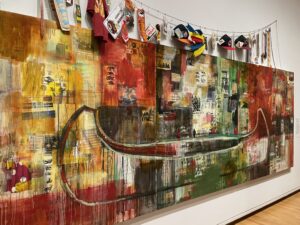
Jaune Quick-to-See Smith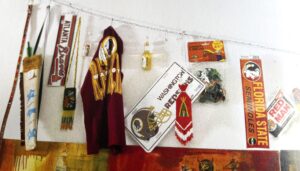 began depicting canoes at the time of the 1992 celebration of Columbus’ arrival in 1492. Needless to say, the arrival of Columbus was no cause for celebration among Indigenous peoples. So this first canoe called Trade Gifts for Trading Lands with White People is full of amusing details, such as the “gifts” strung across the top of the painting are Indian themed kitsch. The canoe is empty unlike her subsequent canoes.
began depicting canoes at the time of the 1992 celebration of Columbus’ arrival in 1492. Needless to say, the arrival of Columbus was no cause for celebration among Indigenous peoples. So this first canoe called Trade Gifts for Trading Lands with White People is full of amusing details, such as the “gifts” strung across the top of the painting are Indian themed kitsch. The canoe is empty unlike her subsequent canoes.
The trade canoes in the exhibition are full to capacity with people, animals, trees, and imaginary creatures. They are often surrounded by a sea of collage that speaks to the abuses and contradictions of native life. But one of Smith’s amazing talents is taking the dreadful and making it amusing even as we don’t lose sight of the horrors. I think this is called Indian humor.
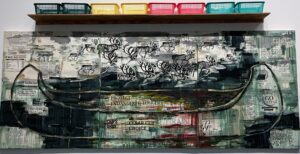
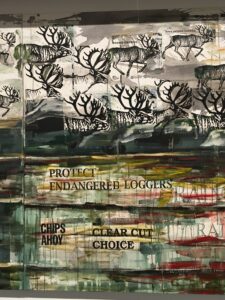
Tongass Trade Canoe 1996, a blockbuster painting, refers to the attempt to bring oil drilling to the fragile Tongass National Forest, the calving land of the Caribou, whom we see galloping across the top of the painting. Above are real laundry baskets suggesting a commodity that comes from oil drilling. The Tongass, after a decade of fighting, was finally protected in 2023 from development (we hope).
Smith’s takes on famous white artists and, in my opinion, outdoes them by adding much more meaning. The maps in the exhibition were initially inspired by Jasper Johns but look where the artist goes with them.
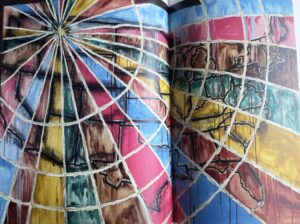
In Homeland, the focal point of the radiating lines is Montana in the upper left where the artist was born. There is a US map underneath, but the radiating lines and colors create an entirely new dynamic. Smith dismisses the traditional lines of US maps, the states, as arbitrarily cutting across Indian lands and tribes.
Other repeated icons in her work, horses and buffalo and food and General Custer in deep trouble.
What the artist cares most about is the land and the deep connection of all Indigenous people to their land in spite of the ravages of the White greed for oil, gas, and other sources of “energy’.
In 2023 she curated a major exhibition at the National Gallery called: The Land Carries Our Ancestors, Contemporary Art by Native Americans that demonstrated that this theme pervades contemporary native art. It included fifty Native artists and essays like “Sky as Place, Land as Body, Landscape as Spiritual Compass,” by heather ahtone and “Land/Landbase/Landscape” by Smith. Creating this exhibition simultaneously with her own retrospective speaks to her deep connection to her community.
“Memory Map” is an outstanding exhibition by one of the most creative thinkers working today.
Jo Harjo’s poetry gives us a day to day reminder of her brilliance:
An American Sunrise,
a poem a day
You can buy the book or listen to a poem a day. Here is a description of the book.”A stunning new volume from the first Native American Poet Laureate of the United States, informed by her tribal history and connection to the land.”
What’s so wonderful is that her poetry is so understandable. And Jaune’s painting is accessible to all of us.
This entry was posted on August 7, 2024 and is filed under
Uncategorized.
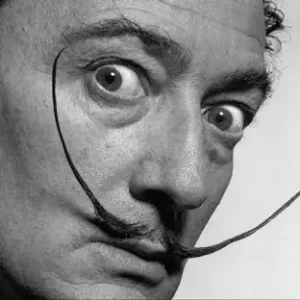
A Visiting Contributor!
Pamela Allara is an art historian and critic who lives in Boston.
Salvador Dali, Disruption and Devotion
Museum of Fine Arts, Boston
July 6-December 1, 2024
If someone had told me in the 1970s that someday that I would write that Salvador Dali is not only an outstanding painter but occasionally even profound, I would have laughed in your face. That self-promoter? Interested only in how much he could earn from paintings of his that were sold? I argued then that his paintings are superficial and he is the least important member of the Surrealist movement, wondering if he should be included at all. After all, he was characterized as a showman and cast out of the Surrealist movement by Andre Breton in 1939. Never chastened, he declared “I believe I am the savior of modern art,” in 1963, a date when one might argue that modernism was already at its end. In 1971 Dali showed up for an interview on the Dick Cavett show with an anteater on a leash. He remained a showman until his death in 1989.Yet, the work remains well worth viewing. I have revised my long-held negative assessment of this artist.
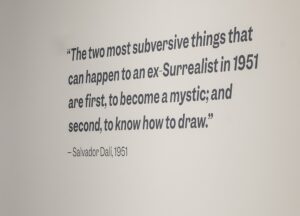
Dalí: Disruption and Devotion
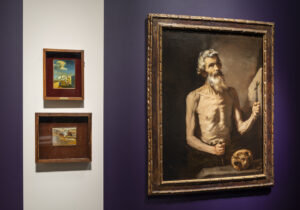
Dalí: Disruption and Devotion
“Salvador Dali, Disruption and Devotion” at the MFA Boston charts the seemingly contradictory paths of his career, from an artist calling for overturning the status quo in art to creating devotional panels testifying to his Catholic faith. Curated by Frederick Ilchman, Chair of European Paintings at the museum, it consists of 30 paintings from the Salvador Dali Museum in St. Petersburg, Florida.
To repeat, despite Dali’s bombast, the exhibit contains excellent work that revives his artistic reputation. In 1949, he met with Pope Pius XII, and renewed his interest in the Catholic faith, and in 1951 traveled across the U.S. lecturing on nuclear mysticism, whatever that may mean.
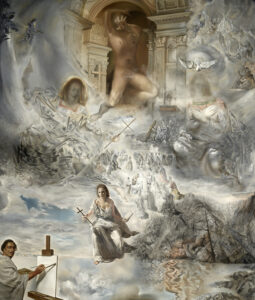
The Ecumenical Council
The largest painting in the current exhibition is “The Ecumenical Council,” from 1960, which includes a naked God, a ‘nuclear’ Virgin Mary, and wife Gala leading the viewer into this strange paradise. Dali is in the left-hand corner recording the whole scene of course. It is the worst painting in the otherwise excellent exhibition. Judge for yourself, it can also be found on the MFA’s website Of course, it earned the most selfies.
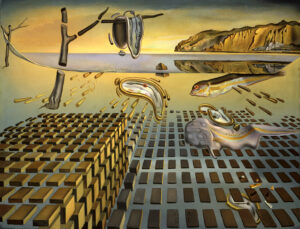
fig 1The Disintegration of the Persistance of Memory
But the smaller paintings can truly disrupt and disturb. The exhibit begins with “The Disintegration of the Persistence of Memory,” from 1952-4, fig. 1. (His most famous painting, MoMA’s “The Persistence of Memory” is not included in the exhibit). Here is the familiar vast landscape and the melting watches from the original, but it is a more mechanized landscape, with what look like missiles shooting toward the horizon. This work is less about memory than a contemporary apocalypse.
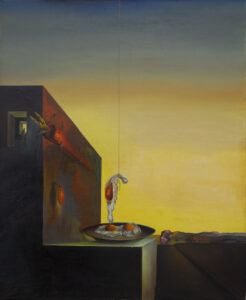
fig 2 Eggs on the Plate Without the Plate
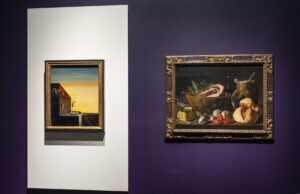
In “Eggs on the Plate Without the Plate,” fig. 2, the egg becomes a hanging figure, at once pitiful and ridiculous, and finally hanging in one’s mind as an image of contemporary violence and crime.
How these paintings work with the larger theme escapes me. The exhibit’s aim is to show how he engaged with the past, and throughout the installation individual works are paired with old masters. There is justification for this approach. In 1919 Dali wrote essays on Durer, Michelangelo and others and urged artists to “Begin by drawing and painting like the old masters.” (An early self-portrait from 1918 was painted in a Fauvist style, although the Fauves were hardly old masters at that point).
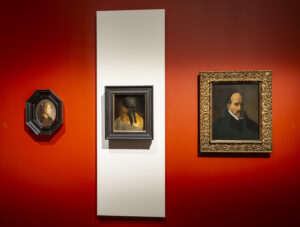
A pairing of a bust of a woman seen from the back paired with a Velasquez self-portrait only makes clear that very few artists can stand up to Velasquez. Still, technically, Dali does have incredible skill, which does indicate he tutored himself in that way.
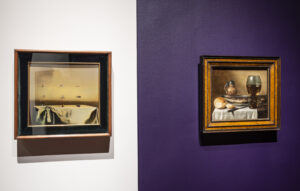
Dalí: Disruption and Devotion
However, perhaps due to lack of patience, I could not see how many of the older works chimed with Dali’s.
One of the few exceptions was an amazing anonymous engraving, “The Temptation of St. Anthony,” f from 1556, with a severed head topped by a gutted fish, and with a diminutive St. Anthony cowering and praying in the corner. It was truly Surreal! In addition, the “Seven Deadly Sins” mid-16th century portfolio of engravings by Pieter van der Hayden was certainly Surrealist before the fact.
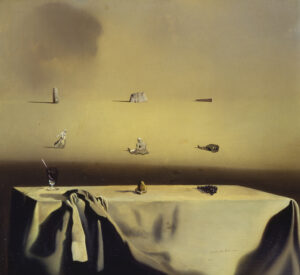
fig 3 Morphological Echo
Again, one major take-away for me was the impressive level of Dali’s technical skill that made mundane seeming paintings memorable. In “Morphological Echo,” from 1936, tiny images of highly detailed landscapes and sculptures float up from a table—a still life that is not still at all. A small painting of a piano on a beach from 1934 looks almost silly, again until viewed closely and in conjunction with its bizarre title, “Atmospheric Skull Sodomizing a Grand Piano.”
Dali claimed early on that “The world needs more fantasy.” In the age of the internet, that fantasy has often become misinformation and we hardly need more of it. But the imagination to re-think and re-see? That Dali can offer us.
List of Figures—all images by Dali unless otherwise noted
- The Disintegration of the Persistence of Memory,1952-54
Oil on canvas
* Collection of The Dalí Museum, St. Petersburg, FL (USA); Gift of A. Reynolds & Eleanor Morse
* Courtesy Museum of Fine Arts, Boston
- The Ecumenical Council, 1960
Oil on canvas
* Collection of The Dalí Museum, St. Petersburg, FL (USA); Gift of
A. Reynolds & Eleanor Morse
* © 2024 Salvador Dalí, Fundació Gala-Salvador Dalí, Artists Rights Society
* Photo © Doug Sperling and David Deranian, 2021 |
* Courtesy Museum of Fine Arts, Boston
- Oeufs sur le Plat sans le Plat 1932
Oil on canvas
* Collection of The Dalí Museum, St. Petersburg, FL (USA); Gift of
A. Reynolds & Eleanor Morse
* © 2024 Salvador Dalí, Fundació Gala-Salvador Dalí, Artists Rights Society
* Photo © David Deranian, 2021 |
* Courtesy Museum of Fine Arts, Boston
- Morphological Echo, 1936
Oil on wood panel
* Collection of The Dalí Museum, St. Petersburg, FL (USA); Gift of
A. Reynolds & Eleanor Morse
* © 2024 Salvador Dalí, Fundació Gala-Salvador Dalí, Artists Rights Society
* Courtesy Museum of Fine Arts, Boston
- All installation shots courtesy of Museum of Fine Arts
This entry was posted on July 26, 2024 and is filed under
Uncategorized.
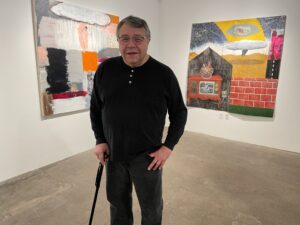
“I am for an art that kicks my soul in the ass. And if we do not have souls, I am for an art that makes me feel like I have a soul, and that it has just been kicked in the ass.”
John Feodorov is always provocative and outspoken on the subject of racism and colonialism, but he mixes it with humor to lighten the blow. He has also used animals frequently as a stand in for white people’s differences from Native beliefs. We make toys of them, while Native people see them as spiritual, creative and embedded in life.
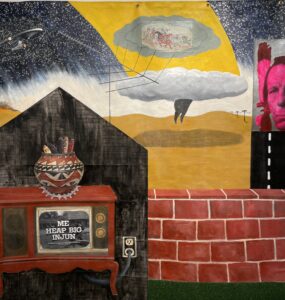
His recent exhibition at 4 Culture “Assimilations” explores the idea of his own mixed background, which he has done indirectly before in other work, but now he foregrounds himself and his family. His mother, a Navajo (Diné) converted to Jehovah’s Witness. “Assimilations” ( I feel there should be double quotes there, as title of show and the fact that he is showing its complexities). He is saying that assimilation
” forces an inherent contradiction within the colonized. Not unlike what Franz Fanon wrote about in Black Skin, White Masks. At least that has been my experience. Some embrace assimilation, while others, like me, cannot make our peace with it. It’s always about not being enough. In my case, not Navajo enough, and certainly not white enough.”
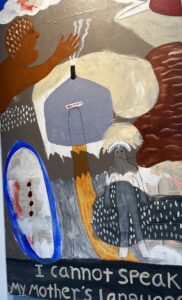
He calls himself a suburban Indian. Buried within his paintings are photographs of boring suburbs in Whittier, California where he grew up. He had two types of contact with Native culture, going back to see his grandparents on the reservation, and the kitsch Indian depictions that American culture spews out as comics, tv shows, movies and documents. In addition to these references, he buries in his paintings, pages from a bible given to him by his mother, the Jehovah’s Witness as well as a Pentecostal hymnals that his mother gave him.
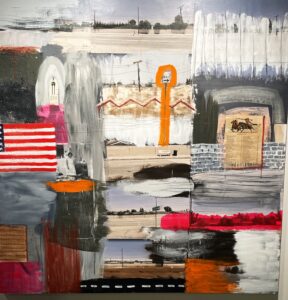
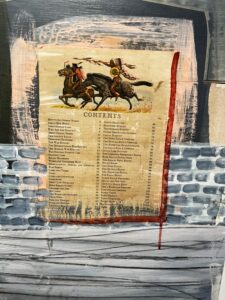
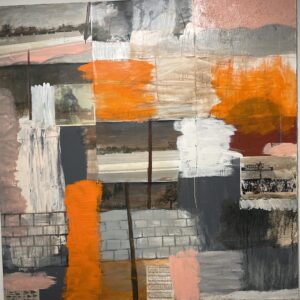
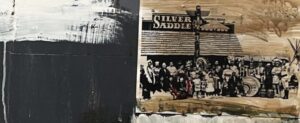
John gave up on organized religion in his twenties, but now he feels that the colonizing of religion still exists inside him. He sees himself as a hybrid.
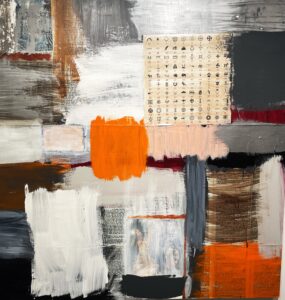
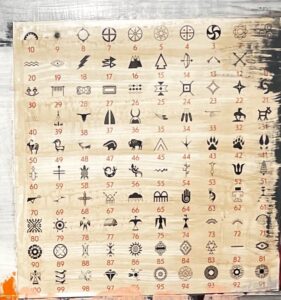
The paintings are actually a dramatic departure for him, featuring large blocks of bright color that make it hard to see the photographs and other images hat he has pasted on the painting. He told me he had recently become interested in De Kooning, who, of course, is part of the colonization of white culture, the great Abstract Expressionists in the 1950s.
But his interest is obviously about the juicy color that swirls around De Kooning’s subjects, almost absorbing them. I can also think of Hans Hofmann with his big blocks of color, but in Hofmann’s case there is rarely any figurative reference. He told me he also looks at Mondrian, Guston, Jaune Quick to See Smith, and Rick Bartow.
Feodorov was moving in the direction of abstraction in the Desecration series, that addressed uranium mining, oil pipelines and coal fracking on Native land. Yellow becomes uranium.
But in “Assimilations” Feodorov’s main point, as it emerges in the color fields, is his own feeling that the Diné beliefs and the white American perceptions of Indians both still exist inside him.
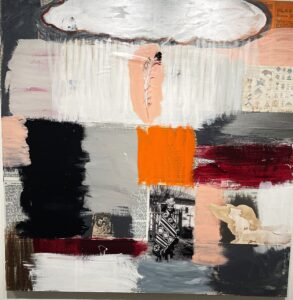
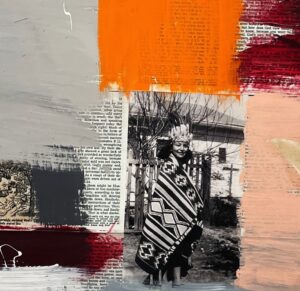
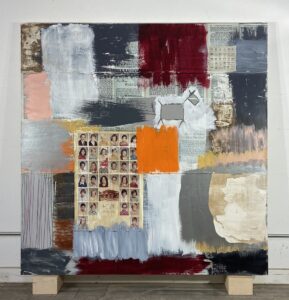
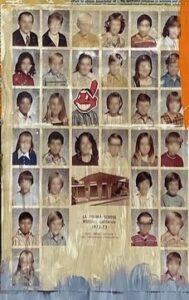
So as we look closely as this dense colorful paintings, we see strange Indian caricatures, “dictionaries” of Indian languages,; a photograph of his mother wearing a Navajo blanket and what appears to be a kitsch headdress, his elementary school class where he is caricatured with a big “Indian” head and much more. The fact that he has closed off the depth with the color squares, is a metaphor for closing off these elements he carries inside himself.
He alternates these paintings with prints based on photographs that juxtapose stills from Wild West movies of cowboys and members of his family on horses in a series called Ambivalence.
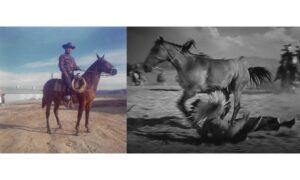

This exhibition includes a work that links to his earlier, more figurative approach My life as a Suburban Ind’n
We see the actual reference points of his early years, especially tv shows and movies caricaturing Indians. The traditional pot with a lace doily on top of the tv epitomizes the contradictions.


The rest of the Assimilations follow the format of large squares of color with racist images just visible. The domination of the color squares over these small Indian caricatures and oddball references speaks to the difficulty of escaping white culture and its caricatures.
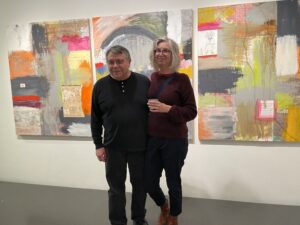
John and Nicole Feodorov in front of his large triptych Memories of a Suburban Ind’n no 1. John Feodorov always seems to be smiling at a private joke, in his art and in his natural disposition, but the joke is actually a very serious awareness on his part that he is never going to escape the colonization of his culture or his own complex position within two cultures. .
This entry was posted on June 12, 2024 and is filed under
Uncategorized.
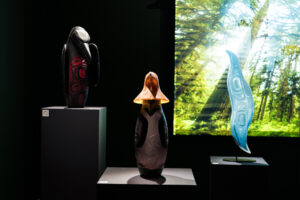
Raven is Back!
Raven, the creator in the Tlingit mythology, rescued humans from darkness by stealing the sun.
“He was a white bird and the world was in Darkness. Raven decides he will try and do something about the darkness, for himself and for the world. As he follows the Nass River, he encounters the Fishermen of the Nights … They tell Yeil ( as Raven was then called) that Nass Shaak Arankaawu ( the Nobleman at the Head of the Nass River) has many treasures in his Naa Kanidi ( Clan House)including beautifully carved boxes that house the light,” So Raven having disguised himself as a seed swallowed by a princess who gave birth to a human baby, enchanted her grandfather and then took the stars, and moon out of their boxes and liberated them. He transformed back into a Raven and flew away to liberate the sun ( see my blog post about Preston’s show in Tacoma on this story)
Preston Singletary wondered what Raven has been doing since mythic times, so in his new series of glass works he brings Raven back, he wakes him up to our disastrous world. This exhibition (which unfortunately closed on June 1 but there is a free catalog) includes Raven responding to the damaged world, as well as new stories “New Takes on Traditional Stories” written by collaborator Garth Stein. His texts are written on the wall above the Raven sculptures tell of the challenges Raven faces as he emerges in the world of today.

“I Dream Therefore I am Raven”
Most of the exhibition is contained in the smaller room at Trevor Gallery, a low lighted space with a large photo of the forest at one end. Interspersed throughout the room are the new Raven sculptures: it feels like we are walking into the forest with Raven all around us joining him in his challenges.
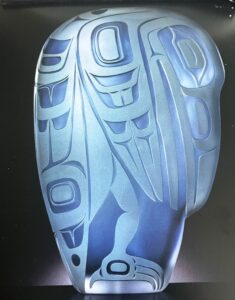
Just outside the entrance is a green blue glass piece Raven’s Dream. Raven dreams of the World Before with clear skies, clean water, uncorrupted animals, “magnificent salmon, bellies ripe to bursting with roe hurling themselves up river to spawn. …Before the world turned on itself with contempt and tore itself apart.” The blue glass raven, as all the ravens in the exhibition, is created by first blowing the glass in a kiln, letting it cool, then carving (sandblasting) the designs that he wants. His images are based on traditional Tlingit form lines, but they are directly related to the stories of Raven’s adventures.
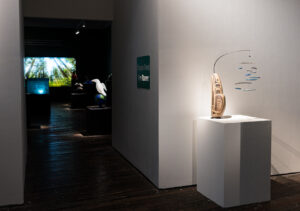
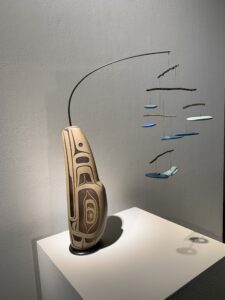
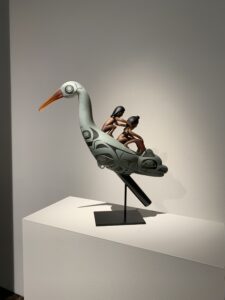
To the right of the entrance is “Blue Light Spirit Mobile” suggesting blue spiritual light floating in the air. Nearby is “Communicating with the Spirits” two children riding on a composite bird/animal that is a shaman’s stick. These works set the stage for our entrance into Raven’s experiences.
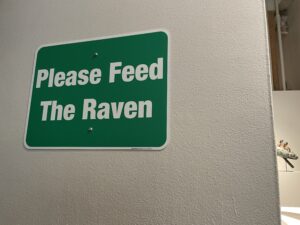
In the narrow entrance signs say “Have you fed the Raven today” and “Please Feed the Raven.” In the stories Raven is constantly in pursuit of food, as he realizes how degraded the salmon and berries he is given have become.
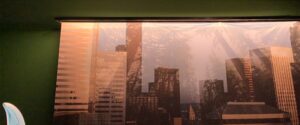

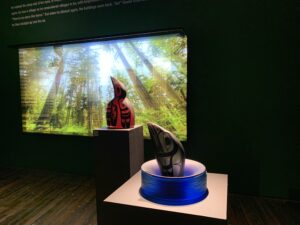
Just as he is waking up from the lush unspoiled world, he sees skyscrapers, but only for the blink of an eye. A large photograph of the forest at the end of the room briefly transforms into a scene of tall skyscrapers , then returns to the forest.
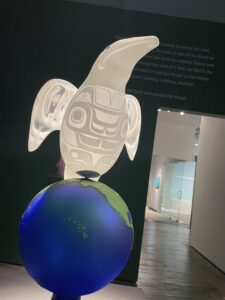
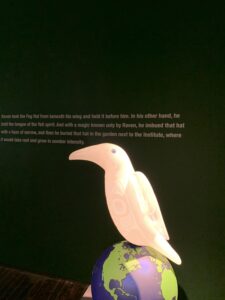
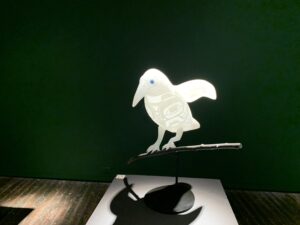
Near the entrance we see two white Ravens, one atop a globe and one on a stick. Raven was originally white, but when he stole and released the stars, moon and sun, the Chief was so angry that he threw ashes at him and turned him black. But after sleeping for such a long time Raven grew new feathers and turned white again. As he arrives among people all glittering and white, they stare at him, so he decides to rub himself with ashes and turn black again so no one will notice him.
Preston: “In my interpretation of what is happening now I want to believe that Raven is battling climate change, protecting the Murdered and Missing Indigenous Women, or helping discover the Boarding School grave sites.”
His first stop is for food, and although he is welcomed, the food he is given does not satisfy him at all, so he seeks the salmon in the river.
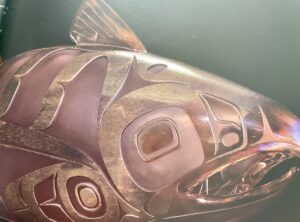
The Salmon King sculpture is orange glass as befits a salmon, and he advises Raven on how to bring the salmon to him by expressing gratitude.
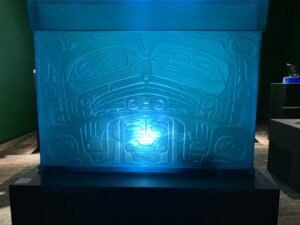
The blue glass “Yeti” box called Weird Adventure. Yeti refers to a type of fancy contemporary cooler. The pattern on the box is based on those of traditional bentwood boxes.
Raven opens the box and finds it empty so he crawls in and closes it, then is swept out to sea. He does battle with evil spirits, then through his magical talents creates a way out.
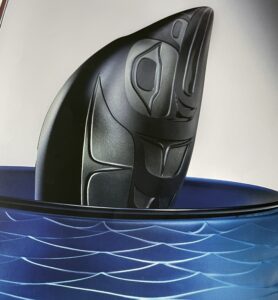
Raven through a hole in the ocean represents his escape as he emerges.



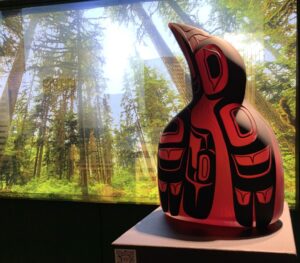
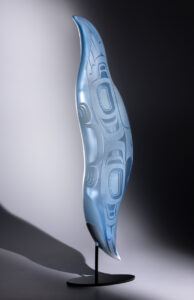
Raven cries to purify the water and to melt the frozen river to liberate the fish there.
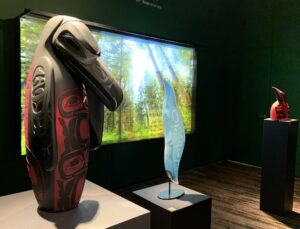
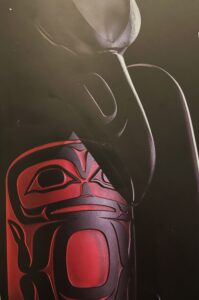
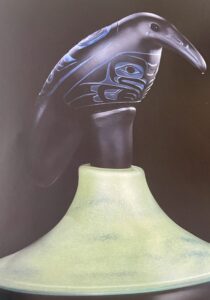
Raven visits the grave sites of the children who have died at boarding school; he comforts them with a fog hat which he has taken from a Petrel by trickery.
Raven Protects the Children with faces of children between his wings is one of the most touching in the exhibition. It underscores the extent to which Singletary transforms the traditional vocabulary of Haida sculpture while still staying true to its aesthetic.
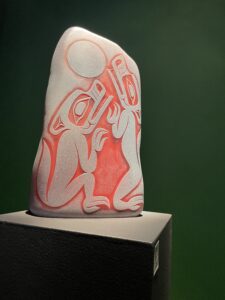
The final event is Wolf sitting on a Rock “observant, cunning, ruthless, merciful, the spirit he would need to lead People into the Future World.”
It is hard to overstate how creative this collaboration is between Stein and Singletary. The sculptures each convey the poignancy of the stories. They are all subtly colored, red, yellow, blue and created with blown and sand carved glass compressed within a larger shape and the form lines of traditional Tlingit sculpture.
Stein’s stories seamlessly bring together the mythic and the contemporary in narratives that both tell us of the degraded state of the world, and the possibilities for healing it.
Yet we see how much must be done. That is why Raven in the end dons a warrior hat 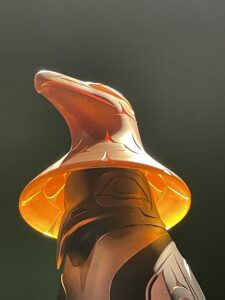
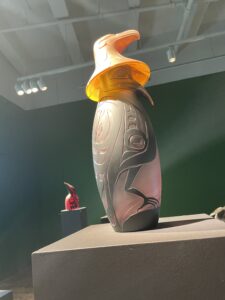
and seeks the help of other animals and birds in his quest.
These hypnotic stories and sculptures give us a deep sense of the quest we must all pursue.
This entry was posted on June 8, 2024 and is filed under
Uncategorized.
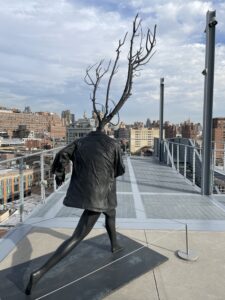 Henry Taylor 8th floor roof of Whitney Museum of Art, November 2023, Untitled, bronze, 2020
Henry Taylor 8th floor roof of Whitney Museum of Art, November 2023, Untitled, bronze, 2020
In early November on a trip to NYC, I saw exhibitions by Henry Taylor, Ruth Asawa ( Whitney Museum) and Kay Walkingstick (New York Historical Society): it was wonderful to see the work of major artists in major venues in NYC that are not part of the old fashioined mainstream white guy art history. Each of these artists is now well-known, each has gone entirely in their own chosen direction.
What a change from not too long ago when the big issues were whether art could be political and whether non abstract art was legitimate. But during my career this change has taken place. When I first started writing in the 1970s and 1980s, the farthest from mainstream were the earthworks artists, giant works in the wilderness created by bulldozing. Although they were full of metaphors, ( as in Smithson’s Spiral Jetty) any realism in a painting at that time was still considered a failure of nerve.
Now we have a wide range of possibilities and no one dictating what artists need to do to be creating meaningful art. Admittedly many artists still go after “success” and the latest thing, but many are freed from that to create as they wish. The result is artists like
Henry Taylor, Ruth Asawa, and Kay Walkingstick.
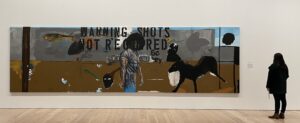
Warning shots not required, 2011 Acrylic, charcoal, and collage on canvas 75 1/4 × 262 1/4 in. (191.1 × 666.1 cm) The Museum of Contemporary Art, Los Angeles; purchase with funds provided by the Acquisition and Collection Committee

Henry Taylor is from Los Angeles. As a contemporary art critic, I am not familiar with him!. Apparently he had his first solo exhibition about two years ago,in his sixties, and here he is at the Whitney Museum, with a huge exhibition “Henry Taylor: B Side”this is an ironic title, suggesting these are the pieces that are on the “other” side of the record, or in other words, less known. But the exhibiiton is a thorough overview of the artists work. Intriguingly I just discovered that one of the works considered his “masterpiece” by some, was omitted – his transformation of the Demoiselles D’Avignon called From Congo to the Capitol and Black Again.
I think omitting it was a good idea, when all of his paintings here are so sympathetic to the subject (usually families and friends), and personal. We don’t need Picasso to legitimize Henry Taylor.
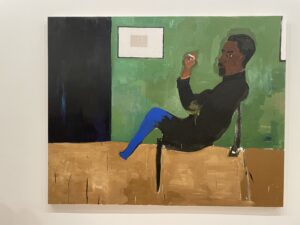
Eldridge Cleaver, 2007 Acrylic on canvas 75 3/4 × 94 3/4 in. (192.4 × 240.7 cm) Private collection
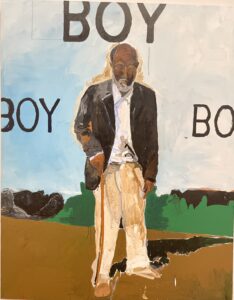
Henry Taylor, That Was Then, 2013. Acrylic on canvas, 95 × 75 in. (241.3 × 190.5 cm). Carnegie Museum of Art, Pittsburgh; The Henry L. Hillman Fund 2013.12. © Henry Taylor. Courtesy the artist and Hauser & Wirth. Photograph by Sam Kahn
Here are two examples of his portraiture the homage to Eldridge Cleaver, above, and the ironic That was Then, below.
Both are painted in flat areas of similar color. Cleaver obviously reminds us of Whistler’s Mother, which is really funny.
That was then shows an old man with “Boy” written on three sides. It is poignant and perhaps sarcastic. Are black men no longer called boys. I hope so. The image tells us that this elderly man certainly was. Taylor’s portraits are full of empathy for the sitter, as we see here.Carefully observed details of the man’s clothing tell us a lot about him
Here are the Obamas (2020)
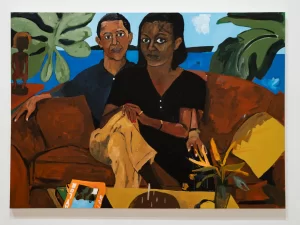
and David Hammons selling snowballs in Africa. (2016) based on a performance Hammons did in NYC. Note the subtle references to Christmas
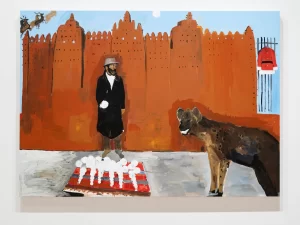
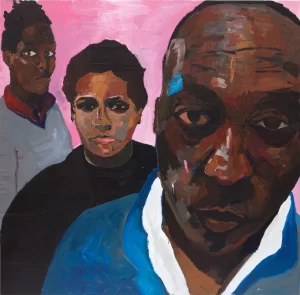
i’m yours” (2015)
I’m yours provides three generations of a family, each with a different expression, but all engaging the artist directly: one is resigned, one is angry and one is questioning.
Resting is a portrait of some of his familly, and their informal engagement with the artist suggests a relaxation, but behind them a third figure lies, is he sleeping, is he dead? We don’t know. 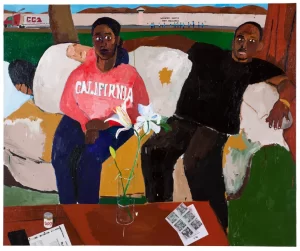
Resting 2011
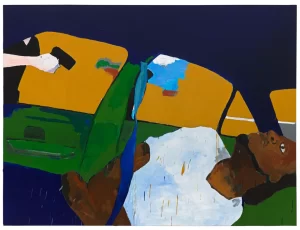
“the times thay aint a changing, fast enough!” (2017), (Philandro Castile)
There is a shock in this painting, as we look at the wide flat areas of paint that send our eyes to Philandro, then we see the gun.
One of the show stopping installations was an homage to the Black Panthers. We could really experience their potency as we interacted with the mass of manniquins in leather jackets and the photographs of Panthers.
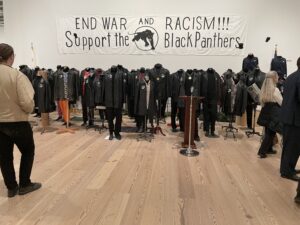
Untitled, 2022 Black Panthers Mannequins, leather jackets, and posters Dimensions variable Collection of the artist and Hauser & Wirth
. 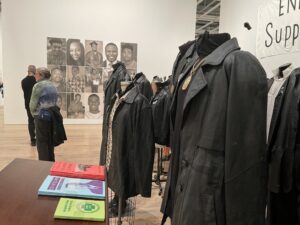
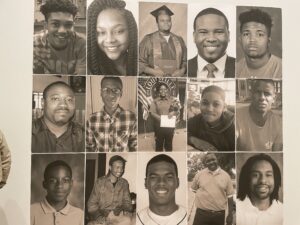
Another powerful experience is the improvisational drawing in the so-called window lounge. Roberta Smith described it well:
“Using an image of Djenné’s Great Mosque, it loosely delineates the forced journey of many Africans from their homeland to a Southern plantation. Then comes the Great Migration that began after World War I. Passing reference is made (in an alluring little landscape) to “Big Momma’s House” in Naples, Texas, from which Taylor’s parents migrated to Oxnard, Calif., in the 1950s. The finale is Chicago and Whitney Houston as a large presiding angel. Here, dashed-off, stream-of-consciousness is perfect. It’s part of a history that all Americans should know by heart.” (NYT, October 18)
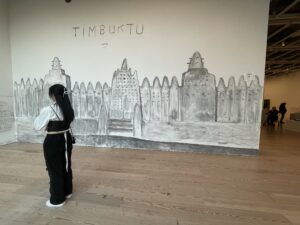
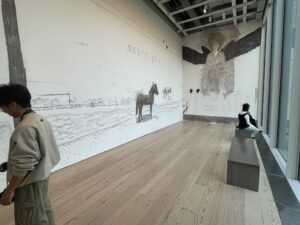
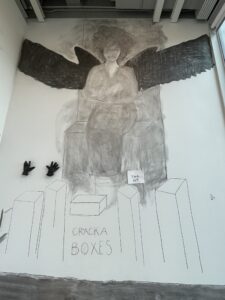
detail Whitney Houston
In one gallery we see this strange tree. What is it about? Trees always lead to thinking about lynching, but here the tree is completely without branches. It has an ominous presence that can suggest a guardian, or a disguise, or a place of confinement.
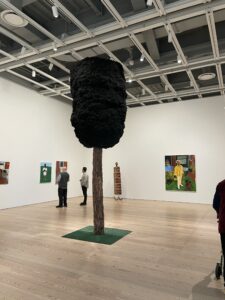
Most of the exhibition consists of portraits of his friends and family, created with empathy. He captures an everyday event and suggests its ordinariness as well as its grandeur.
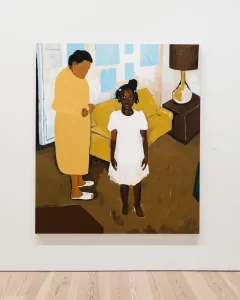
the dress, ain’t me, 2011 Acrylic on canvas 84 1/4 × 72 in. (214 × 182.9 cm) Private collection; courtesy Irena Hochman Fine Art Ltd.
Taylor gives us intimacy. His parents migrated from East Texas to Southern California during the Black Migration of World War II, Taylor grew up in Los Angeles. When he went to art school he worked at Camarillo State Mental Hospital, from 1984 to 1995, making portraits of the people he met. 19 of those portraits are included here, suggesting his empathy for the patients.
“Henry Taylor: B Side” includes sports stars and political stars as well as ordinary people. But the stars look approachable and the ordinary people look like stars.

Untitled, (Obamas) 2020
Also at the Whitney is “Ruth Asawa:Through Line”
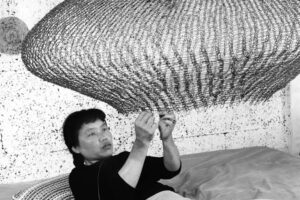
Ruth Asawa as a Japanese American was interned during World War II, but she had the incredible luck to be with artists that taught her a great deal—- specifically animators from the Walt Disney Studios, who taught art in Rohwer Relocation Center in the Southeast corner of Arkansas. She was fortunate also in being allowed to leave to go to school. In 1946 she attended the avant-garde Black Mountain College
At that time she began creating what became her famous looped wire sculptures, a technique she learned in Mexico. Here we see one example of her sculpture from the Whitney Museum exhibit “Ruth Asawa Through Line”. This piece has a long title:
Hanging Six-Lobed, Complex Interlocking
Continuous Form within a Form with Two
Interior Spheres, 1955 (refabricated
1957–58). Brass and steel wire
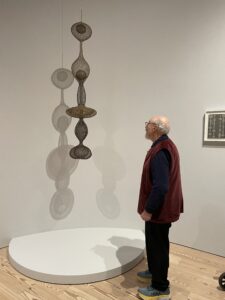
The main theme of the exhibition is her extraordinay drawings, using line. Of course the sculpture above also consists of line, but as we experience her varied media and line, it enriches our understanding of her sculpture as well. Here are two unusual pieces.

Untitled (S.003, Freestanding Reversible Undulating Form), 1998 Bronze Private collection
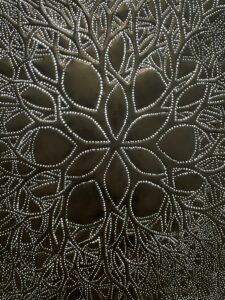
Untitled (SD.254, Tied-Wire Sculpture Drawing with Six Petals in Center), c. late 1960s Tin 32 ¾ x 32 ¾ x ¼ in. (83.2 x 83.2 x 0.6 cm) Private collection
The exhibition is full of notebook sketches that reveal her deep exploration of growing patterns in nature, such as we see here executed in tin.
We feel a whole new insight into line as she creates in so many different materials.
At the New York Historical Society Kay Walkingstick Hudson River School created a thrilling series of paintings overlaying historical American landscape paintings with native signs, reoccupying the land
What we see are brilliant paintings of landscape and seascape and in the foreground are emblems of native tribes as though protecting the land.
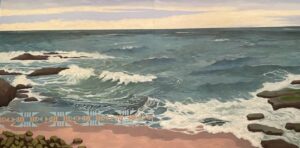
Aquidneck after the Storm 2022 oil on panel in two parts, Colleection of Charlotte and Herbert S. Wagner III
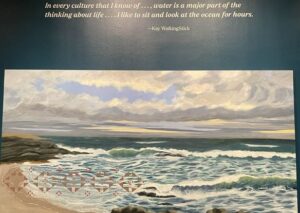
Wampanoag Coast, Variation II, 2018 oil on panel Collection of Agnes Hse, PhD and Oscar Tang
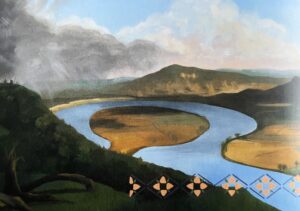
Thom Where are the Pocumtucks2020
As in Thomas Cole ‘s famous painting of t he Oxbow
You can see her overlay more clearly here
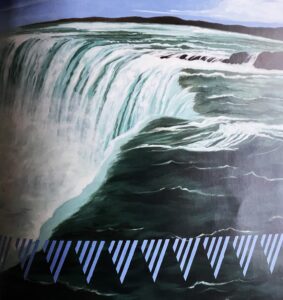
Niagara 2022
overlay with Haudenosaunee pattern
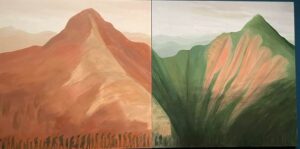
Farewell to the Smokies Trail of Tears 2007 oil paint on wood panel,Denver Art Museum
About this painting the artist wrote:
“Its about the traumatic experience of leaving home- leaving this beautiful home”.
From the catalog by Wendy Nalani E. Idemoto:
” the Cherokee painter felt the pull of her ancestral land the first time she drove through the present day Carolinas and tennessee. Ghostly silhuetts march across her seeking mountainscape, referencing the forced eviction of her people from their homelands in the 1830s along the Trail of Tears.
This entry was posted on January 7, 2024 and is filed under
Uncategorized.
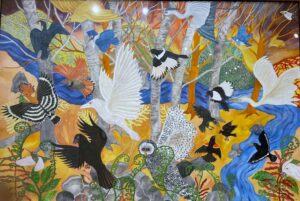
Linda Okazaki: Into the Light
Retrospective Exhibition to February 25, 2024
Bainbridge Island Museum of Art
Dazzling color paired with emotional depth and brilliant handling of the watercolor medium strike us right away in Linda Okazaki’s paintings in her retrospective exhibition at the Bainbridge Museum of Art.
Okazaki has lived in Port Townsend for decades, and before that she lived in Eastern Washington, attending Washington State University for two degrees and then joining the faculty there in the 1970s. She was part of an informal group of faculty and graduate students, a relaxed connection because of the isolation of Pullman. I can remember when I was on the faculty there in the late 1980s (long after Linda Okazaki had left) the rural setting affected the artists in unusual ways. We had parties to look at the stars, bonfires for the fourth of July, and still plenty of time to work. The artists often engaged with the unique landscape, its stillness, its creatures, its odd palimpsests of earlier times.
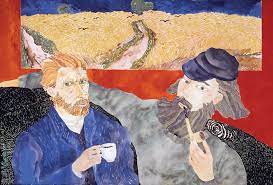
Gaylen Hanson, by my time retired and painting full time in the tiny town of Palouse, was one of Okazaki’s professors. Near the beginning of the exhibition is a “studio conversation” of Gaylen and Vincent Van Gogh. We see Hanson’s presence in her art in the benevolent animals and birds that fill her paintings.
 But her birds multiply and congregate and disperse as in the wonderful recent painting, Birds Take Flight into Twilight, 2023. We see twenty different species of birds, each carefully observed, in a landscape filled with a rainbow of colors.
But her birds multiply and congregate and disperse as in the wonderful recent painting, Birds Take Flight into Twilight, 2023. We see twenty different species of birds, each carefully observed, in a landscape filled with a rainbow of colors.
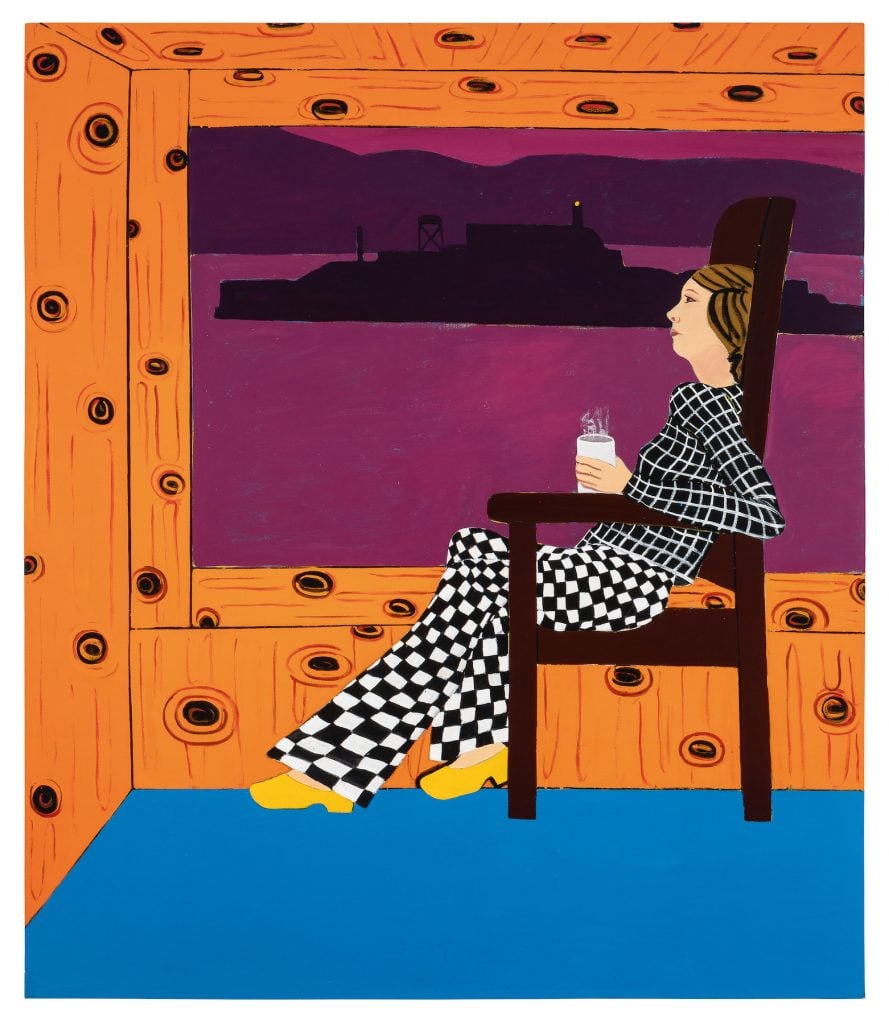
Another inspiration was the Bay Area artist Joan Brown, who also pursued a personal vocabulary of self portraits, dancing and swimming, in a fantasy world.
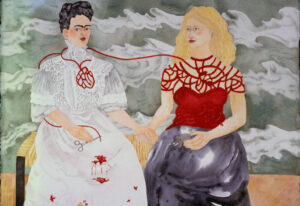
Also important to her was the anguished imagery of Frida Kahlo, as we see in Letter to Frida, 1985.
The exhibition has numerous themes, but they are not clustered together; rather Curator Greg Robinson, in collaboration with the artist, conducts a symphony of phrases that build on one another, and repeat, each with a new variation. The themes given are “Personal Narrative, Domesticity and Nature Morte, Dream Logic, The Mother Wound, Landscape and Waterscape, Music, Song, and Theater, The Briarcliff series, and Birds.
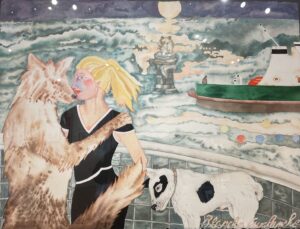
My own response is that water is the dominant subject that encompasses all the others. First, there is the transparency of watercolor which conveys many moods. At the outset of the exhibition, we see Evening Departure, 1980. The sea (Puget Sound) swirls around the boat, as the artist, accompanied by her dog, is held in the arms of a large wolf. The embrace is tender, but the image suggests anxiety. This represents on one level her departure from many years in Eastern Washington to live in Port Townsend on the Olympic Peninsula.
But on another level, we can sense her fear of starting over in an entirely new environment through the imaginary, but gentle embrace of a wolf.
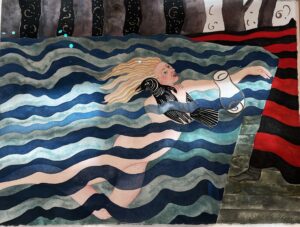
In River Story Return, 1989, the artist now depicts herself nude in the water, carrying a raven and reaching for the shore as a glass vessel floats toward her and a person in a red and black striped robe fails to connect to her. Desperation is palpable, expressed through the color, textures, and images.
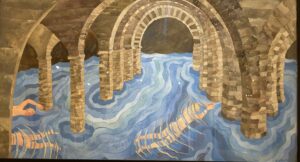
Crypt Swimmers heightens the sense of danger as several figures swim among heavy columns and arches.
When Okazaki was six, her mother was murdered by a stalker who then committed suicide. For the first time, the artist is showing several works that refer to this trauma, each more explicit than the last. The earliest is a pencil drawing made while in art school, but later large watercolors confront this painful subject with a courageous directness.
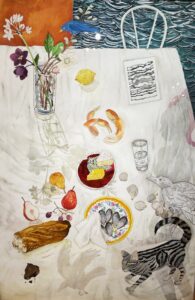
Not surprisingly then, the overall sensation of the exhibition is one of unease, everything is off kilter, filled with undecipherable metaphors, particularly in the still life paintings of tables set vertically against the picture plane and filled with odd objects as in Leaving the Table (above)
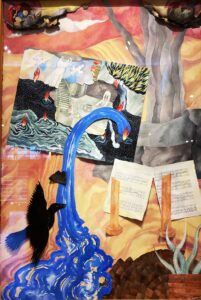
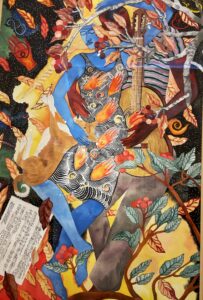
Much of the imagery is from dreams, dreams that suggest struggles to just find a firm footing. as in Music is the Muse ( left) and Fire Inside the Heart ( right)
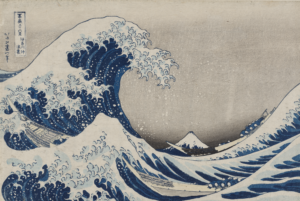
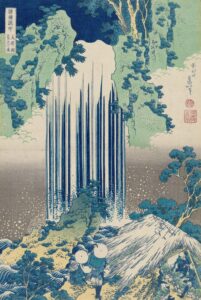 It It is timely that the exhibition “Hokusai Inspiration and Influence” is at the Seattle Art Museum: Hokusai was a master of painting water. The artist clearly has an affinity with him.
It It is timely that the exhibition “Hokusai Inspiration and Influence” is at the Seattle Art Museum: Hokusai was a master of painting water. The artist clearly has an affinity with him.
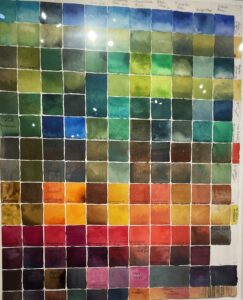
But I will end where I began with the dazzling color: Okazaki immersed herself in a study of Goethe’s color theory and then made her own color charts in order to exactly convey the emotions that she wanted to express. So seeing these paintings through color first gives us a feeling of comfort and sometimes joy, even as the paintings themselves take us on a fantastic adventure.
Below is Hunger Artist, Pond with Old Spirits and Dream at Salt Creek for those who make artifact.
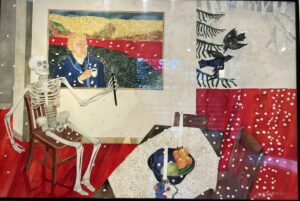
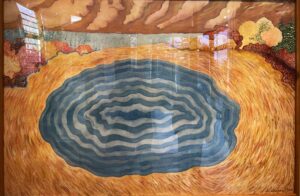
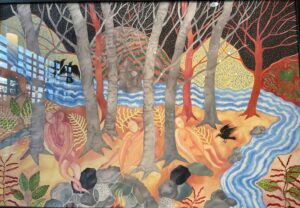
This entry was posted on December 23, 2023 and is filed under
Uncategorized.

This holiday be sure to make time to go to the Seattle Art Museum to see “Hokusai Inspiration and Influence” (to January 21) and “Calder: in Motion, The Shirley Family Collection” (to Aug 4, 2024.) Both expand our understanding of these two famous artists. In “Hokusai” we see the larger context of his work possible because this exhibition comes from the Boston Museum of Fine Arts, a pioneer collector of Japanese woodblock prints. The Calder is a delightful exploration, the first in a series based on the wonderful gift of forty-five works by Calder by Jon and Kim Shirley.
Katsushika Hokusai (1760-1849) is familiar to all of us for his Great Wave also known as “Under the Wave of Kanagama” part of his Thirty-Six Views of Mt Fuji. It depicts three fish delivery boats caught up in a huge wave (had you noticed there are three boats in the wave?)
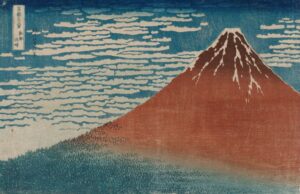
Thirty-Six Views of Mt Fuji (1830 -31) was immediately popular. The exhibition demonstrates that artists from then to now have been inspired by it. Hokusai moved beyond the traditional scope of ukiyo-e prints that present Kabuki actors and women dressed in beautiful clothes (his teacher Katsukawa Shunsho’s specialty). Ukiyo-e means “pictures of the floating world,” and that world was the well-off educated urban middle class of Edo, Japan (1615-1868). Hokusai expanded those subjects to include landscape, folk tales, history, and literature.



The exhibition includes his teachers, his pupils and others who were inspired by Hokusai.


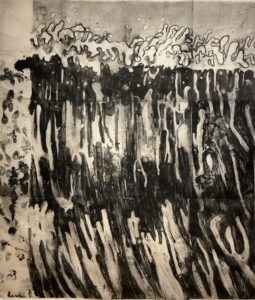
Wave(2006), a seven foot intaglio print by Peter Soriano, suggests we are inside the wave with its vertical thrust of water that breaks at the top.
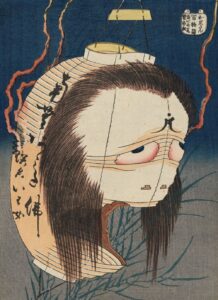
One unusual series is One Hundred Ghost Stories (Hyaku monogatari). The most famous, The Ghost of Oiwa (Oiwa-san) has a strange distorted face on a lamp. According to the catalog:
“A man killed his wife in order to marry the rich girl next door, using a poison that caused poor Oiwa to become disfigured before she died. Her ghost returned to torment the killer by possessing everyday objects, such as the lantern that takes on the distorted shape of her dying face. “
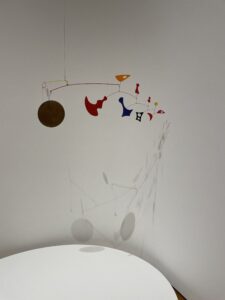
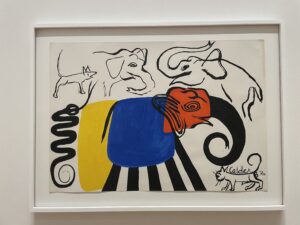
“Calder: in Motion” ranges from large complex hanging mobiles to tiny wire sculptures of animals. I was amazed at the astonishing skill involved in putting these works together. How did Calder get them to balance? How did he decide how to attach the different parts, what colors work? But above all you see the playful humor of Calder, a perfect exhibition for these depressing times.
My favorite work by Calder is still his wonderful circus. I saw it at the Whitney many years ago, along with a movie of Calder manipulating the tiny wire animals. It came out of 1920s Paris, that exuberant period of experimentation in all the arts. Calder set it up in living rooms and the celebrity artists of the time came for the evening watching him bring the little circus alive; he even had music.
In this exhibition we see a set of seven prints of the circus performers that remind us of this playful, experimental era.
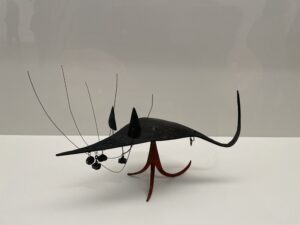
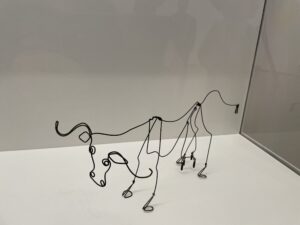
I also loved the Bird, the Rat, and the Cow, created out of wire and found materials. Calder’s ability to capture the nuances of moving animal forms in just a few lines, or pieces of wire, is the result of making hundreds of quick linear drawings at the Bronx Zoo in the 1920s.
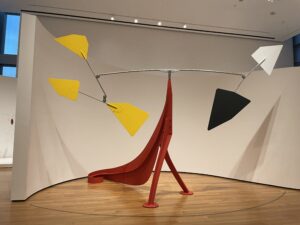
Calder works from very small to very large. Space itself was a primary material for him, and we have to look up and down and sideways to fully experience his inventive work.
Although using different media in different eras, both Hokusai and Calder are about motion, scale and perspective. Hokusai pioneered a landscape art that included great changes in scale (he was familiar with European linear perspective; although his overall image size was small, we perceive vast distances. His other focus was moving water of which he was a master.

In the 1930s Calder began to create mobiles that are thought of as abstract. He also began to make monumental stabiles that shape space but touch the ground like Eagle in the Olympic Sculpture Park.
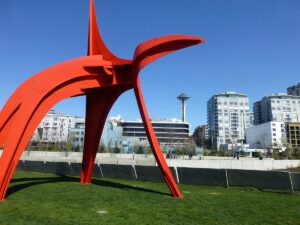
Given this title, I like to think animals are lurking behind all the abstract forms.
Expand your sense of space as you visit these two shows!
This entry was posted on December 22, 2023 and is filed under
Uncategorized.
Indigenous Artists and Climate Change
National Nordic Museum, 2655 NW Market St 98107, ph: 206.789.5707 Hours: Tues-Sun 10am-5pm; Admission: varies by age, see website; FREE on first Thursdays
Sorry it ended on Nov 26.
“Arctic Highways” by Meryl McMaster (b. 1988) What Will I Say to the Sky and the Earth II, 2019 (in the series “As immense as the Sky”) Print on aluminum
Finally, museums are offering us exhibitions that directly address climate change. “Arctic Highways” at the National Nordic Museum, until November 26, features twelve Indigenous artists from the circumpolar North (Sápmi, Canada, and Alaska) who address “the silent and the silenced knowledge” of their Sámi culture. The Museum of History and Industry ( MOHAI), until March 3, 2024 , features an interactive exhibition “Roots of Wisdom: Native Knowledge, Shared Science” developed by the Oregon Museum of Science and Industry. Entirely interactive, it reaches out specifically to ages 12 – 14, but anyone can enjoy it.
“Arctic Highways” emphasizes common themes and shared concerns among Nordic cultures, beyond the artificial borders of nations. It began as an artist residency in Granö, Sweden and has now grown into a traveling exhibition and a book. The artists boldly experiment with a wide range of media, from traditional crafts to video art.
The idea of “arctic highways” creates connections between cultures: “Highways that are cultural and spiritual, real and thriving – but as invisible as the system of national borders that have imposed their rigidness and weight upon us, pitilessly trying to nullify the free flow of ideas and identity connecting our souls.” (museum label)
Several of the artists are from traditional reindeer herding families. They are acutely aware of the changes caused by warming weather, as well as alternative sources of energy filling open space. Wind turbines severely disrupt the grazing land of reindeer and melting snow alters migration and herding rhythms.
Maureen Gruben (b. 1963), Aidainnaqduanni, Aurora, 2020. Print on aluminum
Maureen Gruber’s striking photograph of three polar bear skins hanging on an abandoned survey tripod, looks like polar bears are climbing the tripods, then it becomes frighteningly clear that they are only skins.
Perhaps the most dramatic photograph in the exhibition is Meryl McMaster’s What Will I Say to the Sky and the Earth II, 2019 (in the series “As Immense as the Sky”): the artist stands against an Arctic landscape, wearing a protective coat with insects embedded. She states “Among the coastal ice flows of Lake Erie, I am covered by various insect species—members of a poorly understood and very important class of lifeforms. There are millions of insect species that are unknown to us but play an important role in maintaining ecological equilibrium. To me they represent the fragile, harmonious balance that we are a part of and that we must take care to protect. Their silence is a warning that we are falling into a disharmonious condition.”
Works by Sonya Kelliher-Combs and Tomas Colbengston address the subject of Church boarding schools in Alaska and Sweden that stripped children of their Indigenous Sámi culture. Kelliher-Combs’s Credible, Small Secrets, consists of 35 finger sized sculptures referencing abuse with human hair, nylon thread, glass beads, and steel pins. Each one refers to a village with credible reports of abuse. Colbengston’s painting is based on a photograph of a boarding school with the children lined up in front.
These artists of the polar North witness change every day, as ice melts, temperatures rise, and animals and humans must change centuries old habits. The show is poignant, but also triumphant because the artists are both witnessing and resisting change.
“Roots of Wisdom: Native Knowledge, Shared Science” Building a Healthy River courtesy of the Oregon Museum of Science and Industry.
MOHAI, 860 Terry Ave N 98109, ph: 206.324.1126 Hours: Tues-Sun 10am–5pm; Admission varies by age see website; FREE First Thursdays 5-8pm
Down on Lake Union at MOHAI “Roots of Wisdom: Native Knowledge, Shared Science” features interactive displays, created in consultation with contemporary tribal members. Each display highlights a different theme and tribe: “Reestablishing a Native Plant” (Eastern Band of Cherokees), “Restoring Fishponds,” (Hawaii), “Rediscovering Traditional Foods,” (Tulalip) and “Saving Streams and Wildlife” (Confederated Tribes of the Umatilla Reservation). We can learn how to build a fishpond in Hawaii and or help preserve an ancient fish. The Lamprey, less glamorous than salmon, also suffer from the dams on the Columbia River. We can restore a river or learn why cane is better than grass near a river. We can weave a basket as we listen to traditional elders speak about caring for the land.
The MOHAI exhibit makes each pairing of contemporary science and indigenous knowledge easy to remember. Most striking perhaps was the section on “biopiracy” in which the question of patenting seeds is raised, a big issue in today’s world. “Native Origins” suggests all the everyday products we use, like popcorn, that originally were created by Indigenous peoples.
We are fortunate to have both of these shows featuring Indigenous creative ideas that suggest a few ways to survive on the planet.
Another interesting exhibit:
M Rosetta Hunter Gallery at Seattle Community College, 1701 Broadway (inside the building) Hours: Mon-Thur 10am-3pm
This Fall at the M. Rosetta Hunter Gallery at Seattle Central College, the exhibition “Lush Computation” explores digital and algorithmic aesthetics. September 26–November 16, 2023. Curated by the exciting artist and director of the gallery, Meghan Trainor, “Lush Computation” explores the idea of resisting AI as these artists manipulate digital aesthetics, rather than using AI generated ideas.
This entry was posted on November 25, 2023 and is filed under
Uncategorized.
From last spring, I forgot to post.
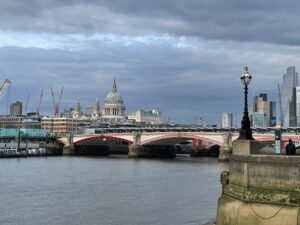
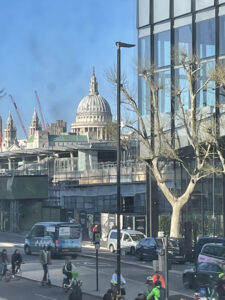
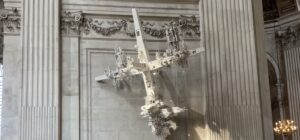
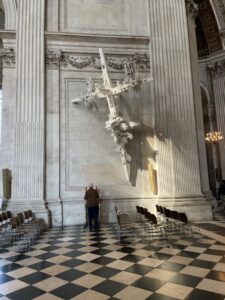
Contemporary cross by Gerry Judah who was born in Calcutta and moved to London when he was ten.
The imagery suggests cities falling apart, catastrophes.
St. Paul also had a lot of statues to colonial leaders with accomplishments like “reduction of French West Indies” meaning taking them over I think.
Statue to a young captain who died at sea in the battle in Burma
A large area behind the altar dedicated to Americans who died in World War II
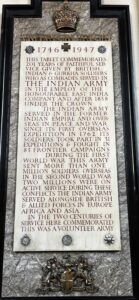
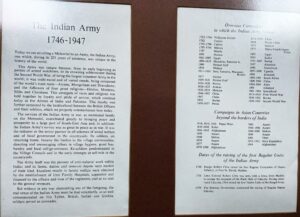
These strange plaques and signs about the Indian Army and all the places they fought for the British.
Personal Experiences
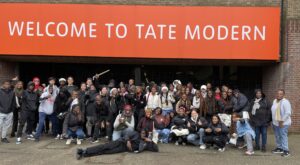
Teens from Botswana on a field trip to London
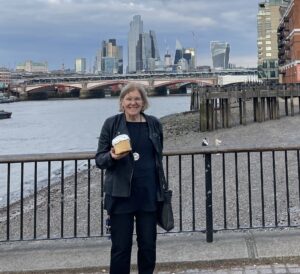
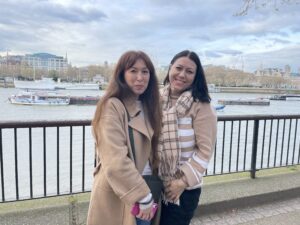
I am holding a large Ukrainian cupcake given me by these two women, Julia and Natalia, whom we met walking along the Thames.
They are coming to the end of their supported situation in UK and wondering what they will do next. Both have families here, children, parents, not their husbands.
We also toured the Globe Theater, for which Shakespeare wrote his
plays.
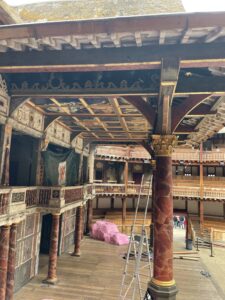
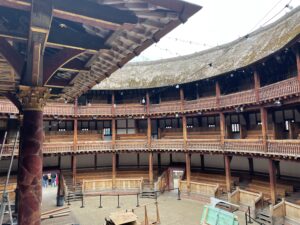
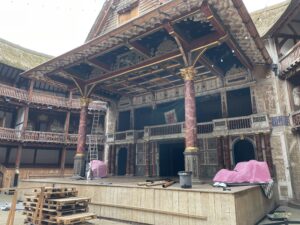
It was rebuilt in the late 20th century funded by Sam Wanamaker.
It has perfect acoustics, no artificial lighting, the audience is visible to the actors which scares the actors ( not the audience)
The people standing in the middle drank beer and urinated creating a stench, so the people in the boxes rubbed oranges on themselves and then threw them at the people below.
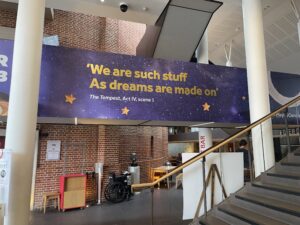
The lobby of the Globe “We are such stuff As dreams are made on” The Tempest
This entry was posted on and is filed under
Uncategorized.








 Jo Harjo reading her poem “Running” from her book An American Sunrise
Jo Harjo reading her poem “Running” from her book An American Sunrise

 Trade canoes are a major theme. In this exhibition we have eight, two actually built of pinewood lath with her son Neal Ambrose-Smith. On one we see a carved white buffalo. The white buffalo has great significance to Lakota and Plains Indians. On June 4, 2024, a white buffalo calf was born in Yellowstone National Park
Trade canoes are a major theme. In this exhibition we have eight, two actually built of pinewood lath with her son Neal Ambrose-Smith. On one we see a carved white buffalo. The white buffalo has great significance to Lakota and Plains Indians. On June 4, 2024, a white buffalo calf was born in Yellowstone National Park 
 began depicting canoes at the time of the 1992 celebration of Columbus’ arrival in 1492. Needless to say, the arrival of Columbus was no cause for celebration among Indigenous peoples. So this first canoe called Trade Gifts for Trading Lands with White People is full of amusing details, such as the “gifts” strung across the top of the painting are Indian themed kitsch. The canoe is empty unlike her subsequent canoes.
began depicting canoes at the time of the 1992 celebration of Columbus’ arrival in 1492. Needless to say, the arrival of Columbus was no cause for celebration among Indigenous peoples. So this first canoe called Trade Gifts for Trading Lands with White People is full of amusing details, such as the “gifts” strung across the top of the painting are Indian themed kitsch. The canoe is empty unlike her subsequent canoes.


















































 Henry Taylor 8th floor roof of Whitney Museum of Art, November 2023, Untitled, bronze, 2020
Henry Taylor 8th floor roof of Whitney Museum of Art, November 2023, Untitled, bronze, 2020




































 It It is timely that the exhibition “Hokusai Inspiration and Influence” is at the Seattle Art Museum: Hokusai was a master of painting water. The artist clearly has an affinity with him.
It It is timely that the exhibition “Hokusai Inspiration and Influence” is at the Seattle Art Museum: Hokusai was a master of painting water. The artist clearly has an affinity with him.


























